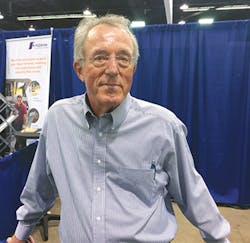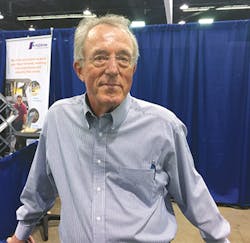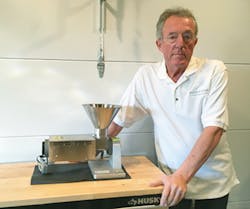Engineer's take on extrusion
Chris J. Rauwendaal has been fascinated with the extrusion process since the very beginning of his career as a new hire at American Enka. "I was bitten by the extrusion bug," said Rauwendaal, president of Rauwendaal Extrusion Engineering Inc. (REE). From American Enka, he moved to Raychem Corp., where he held successive positions that familiarized him with a broad range of polymer processes, including extrusion, molding, post-forming operations, polymer characterization and rheology. He calls his time there a tremendous learning experience. "Raychem, at the time, had many bright people doing really good work," he said.
That training provided the basis for the launch of his Auburn, Calif., company in 1990. Today, REE develops screws and mixers for specialized applications and runs educational seminars for processors, a service he calls crucial to the industry. Trained as a mechanical engineer in Europe, Rauwendaal has opinions about how to improve the quality and throughput of extrusion machinery. He recently shared his views with Plastics Machinery Magazine senior correspondent John DeGaspari.
Tell us about your background. Why did you decide to become a mechanical engineer, and how did you become interested in extrusion?
Rauwendaal: Mechanical engineering is something I chose because I always liked to tinker with mechanical devices. I decided I wanted to become an engineer at an early age, even though there were no engineers in my family at all. I have been working now as an engineer for 44 years; I still get excited about it, and I feel very fortunate.
Was there a "eureka" moment when you realized you wanted to focus on polymer processing?
Rauwendaal: That really happened by coincidence. My first job was at American Enka, in Enka, N.C., a company that manufactured man-made fiber. They told me that I was going to be their extrusion person. I had to learn a lot, but I really enjoyed it and I was able to do some good work when I was there. I decided to leave in 1977 because the fiber industry was going through hard times, but I wanted to stay in the polymer industry. I wanted to work in extrusion because I felt that it was a fascinating subject where there is still so much technology to be improved, and the theory still was pretty much in development.
At my next job at Raychem Corp., I worked in extrusion and compounding and characterization of polymers. That was a tremendous learning experience for me. It was a very diverse company when it came to materials and processing technology, and they had developed a number of proprietary processes and machinery.
How does the approach to process technology differ between the U.S. and Europe?
Rauwendaal: As a mechanical engineer, I am drawn to the machinery. When you look at process engineering, in Europe it is typically part of mechanical engineering and in the U.S. it is part of chemical engineering. In the U.S., people who work in polymer processing tend to have more of a materials focus, and the Europeans tend to have more of a machinery focus. I think that's why you see that most of the machinery developments in extrusion tend to occur in Germany and in Austria, where they have very good engineering education but also a good focus on smart design of machinery and close cooperation between industry and universities. We could learn from that.
What have you observed when visiting extrusion plants to troubleshoot production problems?
Rauwendaal: I observe lack of training; people simply not knowing the things that they should know. I see a lack of instrumentation, lack of ability to interpret information from instrumentation, lack of data acquisition capability in a company. Even in cases where there is a good data-acquisition system, the people often, or at least in some cases, are not trained to use it correctly to take advantage of it. Education is a really important issue. That's why I do a lot of teaching; I really value that, and I feel it serves a very useful purpose.
What advice do you have for processors choosing an extruder screw?
Rauwendaal: In many cases, companies use materials that are not general purpose, and that require a more customized design. That's typically what we [at REE] do. To do that, what you need is the performance requirements, but you also need the properties of the plastic that must be taken into account into the screw design, and the same with die design. You need to know the rheological properties; you need to know the thermal properties; and especially the information on the thermal stability, which is typically measured by the induction time.
What about primary machines? Any advice for customers choosing an extruder?
Rauwendaal: What I see quite often is that a company buys a machine, and they basically rely on the machine manufacturer to tell them what they need. This is not always a good idea, because there are certain things that machine manufacturers might not incorporate. Also, some extruder manufacturers are not up to date on the latest developments in extrusion. What I recommend is not to rely solely on the recommendations of the extruder manufacturer. I believe that it is really important that you have a person either in-house or an external expert who knows what is really important and is able to set the right specifications. I have helped a number of companies get the right extrusion equipment. Getting the wrong extrusion equipment can be extremely costly.
What are a few examples of major technical developments in extrusion?
Rauwendaal: One of the developments that I find very significant is high-speed single-screw extruders. There are machines that can run at 1,000 or 1,500 rpm, so a relatively small 75mm extruder might have an output range of 4,000 to 5,000 pounds per hour. There are even small extruders of 35mm that have output ranges of 700 to 900 pounds per hour.
Another development that I believe is quite significant is the grooved-barrel extruder, where the entire length of the barrel is grooved. There are a number of designs available today that have very impressive performance. The IKT [Institut für Kunststofftechnik] in Germany is doing very interesting work now on relatively small extruders that have very impressive capabilities in terms of output and process stability.
What enables the high throughputs on these extruders?
Rauwendaal: It's mostly efficient melting and heat transfer in the case of the grooved barrel extruder. If you have a smooth barrel, you are always limited by the fact that the barrel has no active surfaces; if you put helical grooves in the barrel, then basically the barrel becomes a screw just like the screw itself. It's almost like having a twin-screw extruder.
What developments have come out of your company that you regard as particularly significant to the extrusion industry?
Rauwendaal: A development that I consider significant is the CRD mixers that use elongational flow rather than shear flow to perform mixing. That is something we developed about 15 years ago; it has been around for quite a long time and is pretty widely used. Erema in Austria, which makes recycling machinery, has recently licensed the technology from us and they are using it in their recycling machines. Other important developments have been the high-heat transfer [HHT] screw, mixers to promote axial mixing, the vortex intermeshing pin [VIP] mixer, and theoretical developments such as the analytical model for melt temperature development in single- and twin-screw extruders.
Is statistical process control (SPC) used to its full potential in extrusion today?
Rauwendaal: I look at SPC as a very powerful tool that should be used by any high-quality manufacturing company, whether it's extrusion or molding or machining parts. I find that the use of SPC is not nearly as widespread as you would expect. We live in a very competitive world today, and if you don't use the relatively simple tools that are available, you put yourself at a serious disadvantage.
Do you have a wish list of technological improvements that you would like to see in the industry?
Rauwendaal: One of the things that I would reach for is the data acquisition systems with intelligence built in that could help the operator interpret information, identify problems and suggest possible solutions. I am a very strong proponent of having very good data acquisition capability — that you need to capture data from the process. You need to capture data intelligently. This means you should know what needs to be measured, where it should be measured, how frequently the data should be captured, what kind of sensors should be used, and what sensors are inappropriate.
Those kinds of details are sometimes forgotten or not considered. I see many extrusion companies that use a pressure transducer with a temperature sensor in the transducer, and they take that temperature as being the melt temperature of the molten polymer. That is completely incorrect, but it is so important and so basic that it really should be widely known.
I also feel that companies that sell those types of transducers should make it clear to their customers that the temperature that they measure is not the melt temperature; it is the temperature of the transducer. If you don't have a good measurement of your melt temperature, you are at least partially flying blind.
What you need is a dedicated melt temperature sensor that is immersed in the melt stream. That is a correct way of measuring temperature, but even that has its limitations, in that it has very slow response.
It is also very helpful to use an infrared melt temperature measurement, where you get very fast response. If you have the combination of the immersion probe and the infrared melt temperature measurement, then you can really understand what is going on with your extrusion process. Unfortunately, this is something that very few companies actually do.
How would you like to be remembered professionally or personally?
Rauwendaal: I basically try to do work that I think will be useful for the industry. If I would be remembered that way, as somebody who made an effort to improve the technology and the level of education, I would be quite happy with that.


